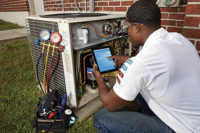However, discovering why the original compressor failed may not be as simple. But it is important for the service technician to find an answer to this. Replacing the defective compressor without finding the cause can surely cause the replacement compressor to fail.
Replacing the compressor a second, third, or fourth time is not advantageous to the service contractor or to the customer. It can cause the service contractor to lose money and quite possibly the customer.
In most cases, upon original inspection of a defective compressor, it is difficult to determine what caused the compressor to fail.
After replacing the compressor, the technician should spend time diagnosing why the original compressor failed. Usually with a detailed inspection the technician should be able to find the cause.
The inspection should include checking:
- Suction and discharge pressures;
- Amount of superheat at the compressor inlet;
- Return gas temperature;
- Discharge gas temperature;
- Amperage; and
- Applied voltage to the compressor.
By comparing these readings to the manufacturer’s specifications, the cause should be easily identified.
Some typical causes of a compressor failure are:
- Liquid returning to the compressor;
- High return gas temperature;
- High discharge temperature; and
- Incorrectly applied voltage to the compressor.
Most of these causes can be found once the compressor is up and running.
When it's not apparent
There are times, however, when the apparent cause cannot be found upon start up. In such cases, the technician should monitor the system’s operation for a period of time so he or she can find the cause. The problem may develop after the system has been running for some time (for example, during or after a defrost cycle) or as a result of an iced evaporator coil.Another helpful troubleshooting tool is to disassemble the defective compressor and examine the valve plates, pistons, crankshaft, bearing surfaces, and windings. This can help immensely in identifying or confirming the cause of the original failure. Although this is a time-consuming step, it is well worth the time and effort.
Also helpful is for the technician to speak with the customer to get the prior history on the system’s operation. Discovering if the compressor has been replaced prior to the tech’s involvement, or if there has been any other major work done on the system, will aid in finding the cause.
Preventing repeat compressor failures is a must for any successful service contractor. Repeat failures not only take away from the contractor’s profit margin, they also tarnish the company’s professional image.
Finding the cause and repairing the problem not only keeps the customer happy, it keeps the contractor profitable.


